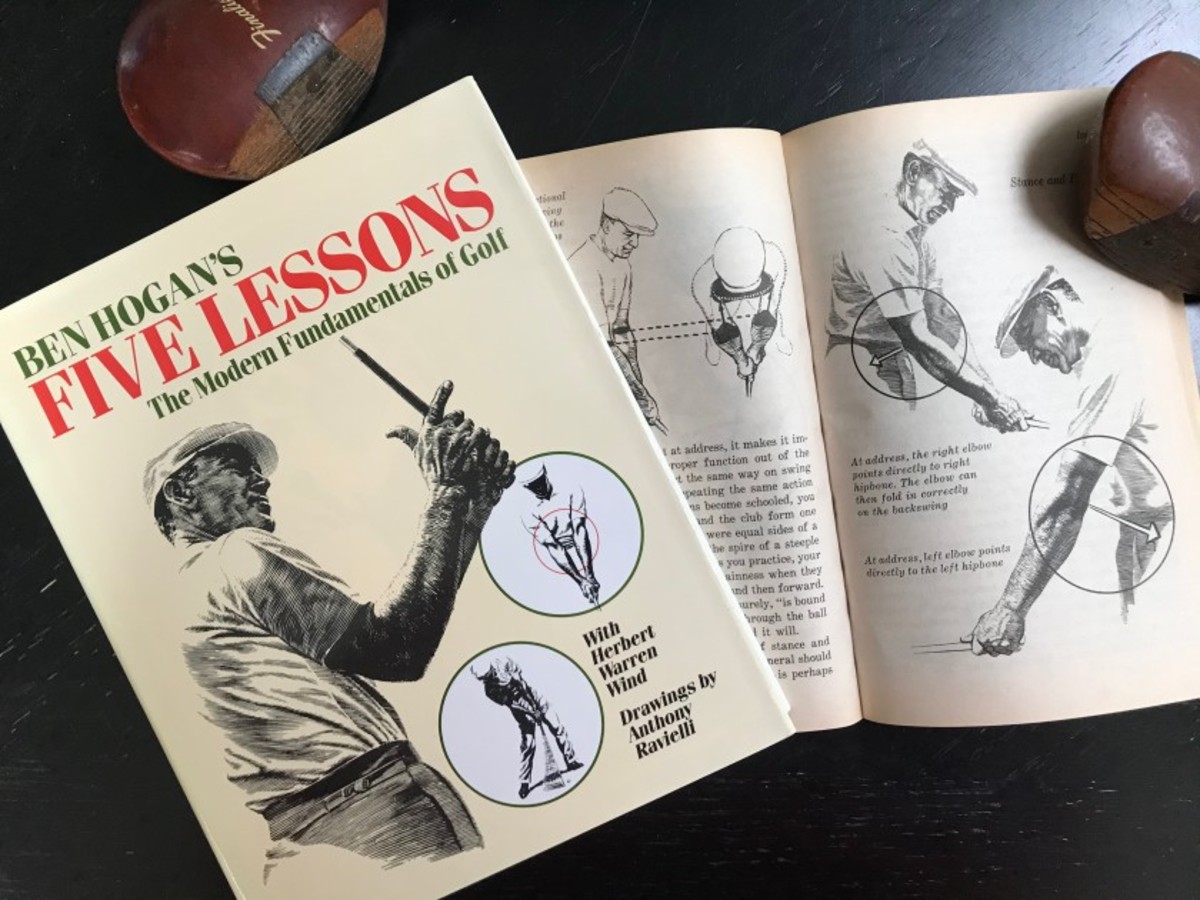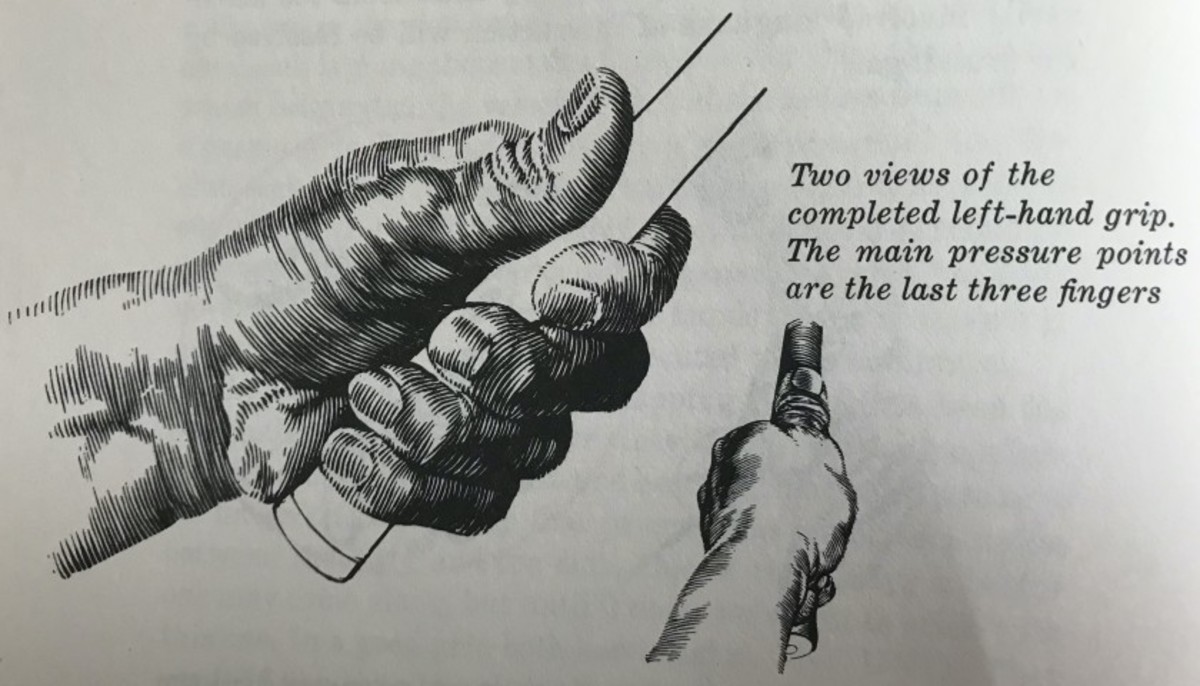Ben Hogan’s ‘5 Lessons’ endures time, technology, scrutiny

Ben Hogan, comfortably ensconced as one of the best golfers in history, left an indelible mark on the game. Success transcended prosperity in another way, manifested within the eponymous instructional book “Five Lessons: The Modern Fundamentals of Golf.”
Sixty-four years later, the book still stands out among golf publishing works. The book is nothing more than a compendium of Hogan’s philosophies, of what he believed to be true.
First published in 1957 by A.S. Barnes and Co., the thin guide has generated more than 1 million copies via hardcover, paperback and e-reader platforms. It has been reprinted multiple times by multiple publishers and largely lauded as one of the top golf books of all time.
Yet, a principal question begs: why has a book, seemingly antediluvian and one that almost didn’t materialize, still resonate today?
The answer is in the details. To examine those details, though, first a bit of a history lesson.
The idea for the book happened innocently enough. After the 36-year-old Hogan survived a near-fatal car accident in 1949 – one in which a 20,000-pound Greyhound bus hit the car in which he and his wife, Valerie, were traveling head-on – The Hawk subjugated fans to his dominance. He defied the odds, not only to walk again, but by also winning six of his nine majors post-crash. His profile rose in the game. In fact, he is only one of five players to win all four major championships. That is, of course, beside the point.

Winning no doubt served as the fuse to the powder keg that became the book. No one could have known it would explode into a massive success. After all, the book pre-dated copious instructional books to come and certainly was not the first.
In any event, as the story goes, in 1956 – with Sports Illustrated in its infancy and barely surviving – Hogan reached out to managing editor Sidney James and pitched an article. At first, James was hesitant and did not give the idea much thought. After mulling it over, he decided to send fabled golf writer Herbert Warren Wind and talented freelance illustrator Anthony Ravielli to meet with Hogan at his office in Fort Worth, Texas.
There, the plan unfolded. The three headed to Colonial Country Club a short while later, and Hogan hashed out an outline. Wind and Ravielli suggested that perhaps the story could morph into a five-part instructional series. The sequence would be presented as a tutorial on the grip, the setup, the backswing and the downswing. The final part would summarize everything. Hogan agreed.
By the end of 1956, Wind had come up with a draft, and Ravielli had painstaking drawn pencil sketches that later would be revolutionized into a scratch-board approach. This technique turned sketches and diagrams into relative life-like drawn imagery. In January 1957, the three got together for a week before Hogan gave his blessing.
As each installment reached conclusion, Wind sent proofs to Hogan, who immersed himself in what he saw, clarifying meaning and instruction. Hogan, a brooding figure, told Wind that each line needed to communicate precisely what he was trying to convey. The first of five successive installments appeared in the magazine's March 11, 1957, issue.
“[Sports Illustrated] thought it was a big risk,” said Bill Scheft, Wind’s nephew, as told to author Neil Sagebiel.
“The first issue came out on Wednesday, and when the editors came in for the Sunday meeting, all they talked about was how everyone at their driving range on Saturday had a copy of the magazine at their feet. Every one of them. That’s when they knew they had a hit.”
Much of what appeared in the weekly installments morphed into the book, co-written by Wind, later in September as a joint venture between Hogan and the magazine. With Hogan’s swing, who wouldn’t want to know his secrets? Who wouldn’t want to emulate the same swing?
However, had James vetoed the idea from the get-go, the chances for any book may have died a quick death.
A BOOK AS EFFICIENT AS ITS AUTHOR
For maximum impact, “Five Lessons” is presented in the first person, as though the reader were receiving a personal lesson from Hogan. The book opens with a foreword, preface and “The Fundamentals.” Each lesson is a chapter.
To affirm a point Hogan wanted to get across, his words are presented in all capital letters. He was known as a tireless worker and hints that “the secret is in the dirt.” Ceaseless practice is key. Hogan also leaves the reader with this: “Reverse every natural instinct and do the opposite of what you are inclined to do, and you will probably come very close to having a perfect golf swing.”
That, in essence, could be why the book has lasted, according to longtime sports and golf psychologist Gio Valiante. There’s little doubt to Valiante, well-versed on Hogan, that he was uber tuned-in to his own mind, a trait often found within top performers. Hogan benefited from metacognition, or being aware of his own thinking.
“It’s a clean read; it’s without conjecture,” Valiante said. “There is no bloviating in it. In fact, if you read Tiger [Woods]’s book ‘How I play Golf,’ his observations on Hogan were that Ben Hogan was a man not prone to conjecture or inaccurate observations. I think the reason people read it is because, at the highest level of the game, they see it speaks truth. It’s not verbose; it’s not dense. If you look at [Nick] Faldo’s books, Jack Nicklaus’, they’re wordy. It’s the difference between Hemingway and F. Scott Fitzgerald. Hemingway would write and just take words out to get to the truth. The other thing that helps is the tone of voice. The tone of the “Five Lessons” is consistent with the personality. Hogan was an efficient golfer; he had an efficient golf swing, and he was efficient with words.”

Hogan’s messages about the setup and training the mind to do the opposite always stuck with Brian Liberati, a Michigan-based PGA teaching pro since 1986. The fact that Hogan was a late-bloomer – winning his first professional tournament at 27 – with a bothersome hook early in his career lends credence that the golf brain can be reprogrammed.
Liberati, in trying to prevent students from retreating to bad habits, introduced drills based on Hogan’s reasoning.
“I definitely agree with the book in that regard, in doing the opposite,” Liberati said. “That’s why if someone is slicing the ball, I’ll try to get them to hook it, just so they feel the opposite. Because then they can come back and meet in the middle. It’s hard to get a person to stop a slice and go straight. But if you go from slice to hook or draw, all of a sudden they can kind of back down and get to the center. If they don’t feel a difference, they will never be able to truly understand it.”
‘FIVE LESSONS,’ LIKE HOGAN, HAD FLAWS
“Five Lessons” may seem dated because Hogan’s fundamentals are based upon the evolution of the wooden hickory shaft and steel shaft. There were no graphite shafts back then, or the technology that has propagated equipment now. To wit, it comes back to the basics of the golf swing. A rose is always a rose.
To the critics, though, therein lies the flaw with the book. There’s just not enough … meat.
Ted Kondratko, a self-professed Hogan protégé and expert, became a PGA teaching pro in 1976 before retiring recently. Like so many other teaching pros, he took a keen interest in the book and thinks it’s more vapid than instructive.
“I have an incredible amount of love toward [Hogan], respect and understand a lot about him because of what he’s done,” said Kondratko, winner of the 1971 Michigan Open. “In the book, he was telling people what he did, but he didn’t tell them how to learn it. The result of that, in my opinion, was that he misled everybody in golf … and that was because of his personality and his problems. He told you the specifics of the result of all the work that he did, but he didn’t teach it in a fashion where you can pick up the book to learn how to do it.
“He took the facts of what someone else could have done if they had a golfing background about the grips, stance, posture, alignment and waggle. He talked about the backswing and the delivery of the club, but he never told you how to practice or how to hit it.”
Liberati said the section about the setup might baffle a starting or average player. To draw an analogy, it would be like telling a beginning reader to write a haiku. On the surface, it’s hard for a novice or basic golfer to twist in their elbows, he explained.
“In a way, I think [the book] is misleading, because Hogan never really divulged all his secrets," Liberati said. “He always wanted to keep a little bit to himself. For the average person, it’s tough. His basic things, I like. But not many people could swing that way, like him. Some professionals? Yes. But most players, no, if they’re trying to emulate him.”
What helps the book along, without question, are the pristine Ravielli drawings and diagrams. They’re drawn to mirror Hogan’s swing, even if not 100 percent accurate.
They are simple, easy to understand and fuse word, vision and comprehension together.
THE SPORTS ILLUSTRATED SERIES
Part 1: The Grip
Part 2: Stance and Posture
Part 3: The First Part of the Swing
Part 4: The Second Part of the Swing
Part 5: Summary and Review
“He was a genius in what he did,” Kondratko said of Ravielli. “That’s another reason why the book became so popular, because he didn’t have any photos or still photos of his real swing. It was all done with what Hogan told him what to do and how to do it, and how to put them in positions where, again, it never really helped anybody.”
If nothing else, Scheft paid a high compliment to Ravielli in his interview with Sagebiel.
“Whenever anyone brought it up, [Wind] would dismiss his contribution,” said Scheft, “[saying] Hogan was helpful and generous with his time, but [Wind] would insist Ravielli’s drawings are what launched the book and are responsible for its success.”
The book has merited a legacy due to Hogan’s success and the belief he could impart knowledge to those driven to be better. Not to be forgotten, it appealed to the subconscious assumption that any golfer could emulate his swing, therefore leading to high-level execution.
Golf’s a funny game. At the highest of highs, when everything feels right, the euphoria is analogous to finding the Ark of the Covenant. At the other end of the spectrum, the lowest of lows, a rod saw blade just might be the proper panacea for those failing graphite shafts. Yet, it always comes back to three things: fundamentals, practice and the player.
Hogan was a disciple of practice. It’s an underlying theme in the book and summed up best by Valiante.
“The best stat I ever read in golf was Tiger’s percentage of [made putts] over the course of two-and-a-half years from 3 feet in. He missed like three putts,” Valiante said. “You know how hard that is? It goes back to Hogan and any great athlete. It’s about the difficulty of doing a simple thing well. Think about that. The difficulty of doing something simple well. Which is why all the professionals converged to fundamentals, and which is why they inherently found a way to Hogan’s book.”
